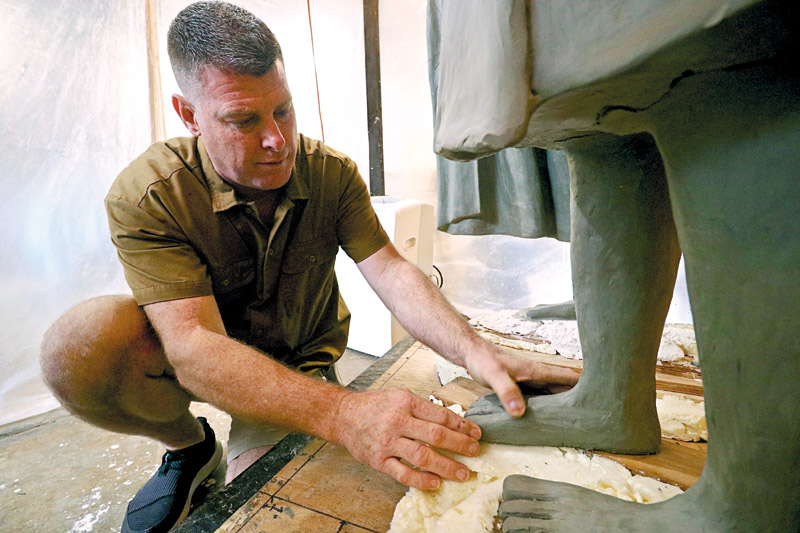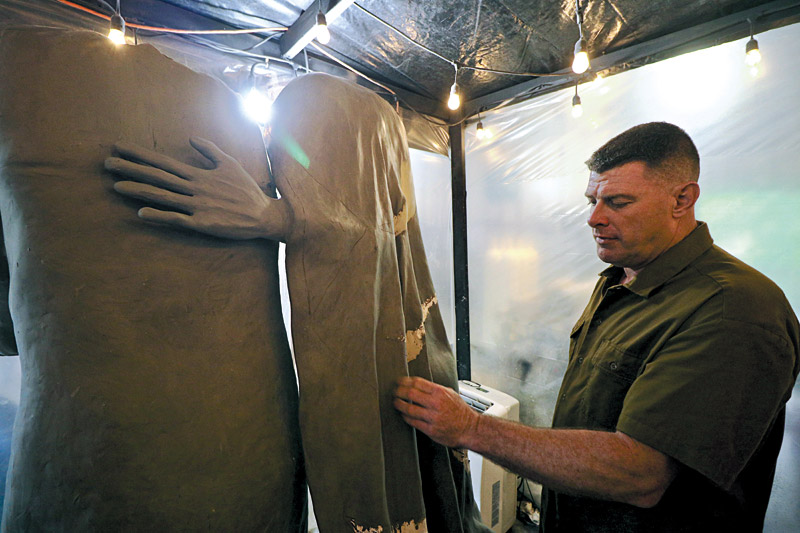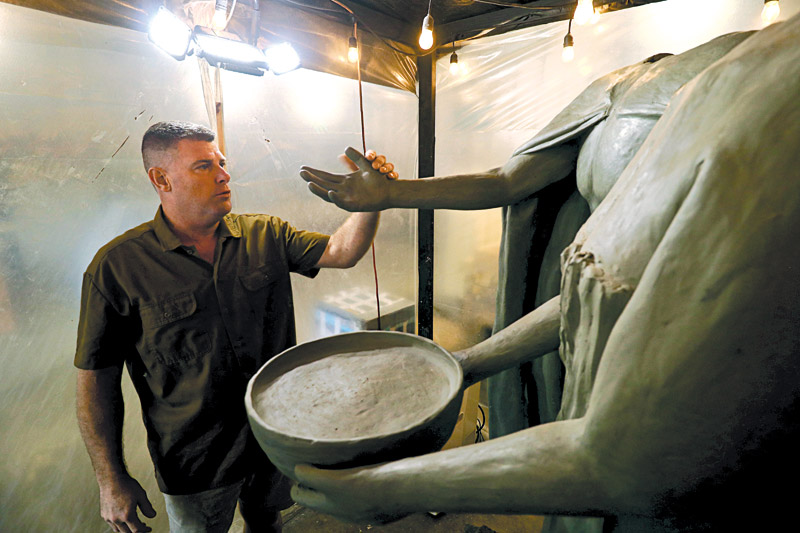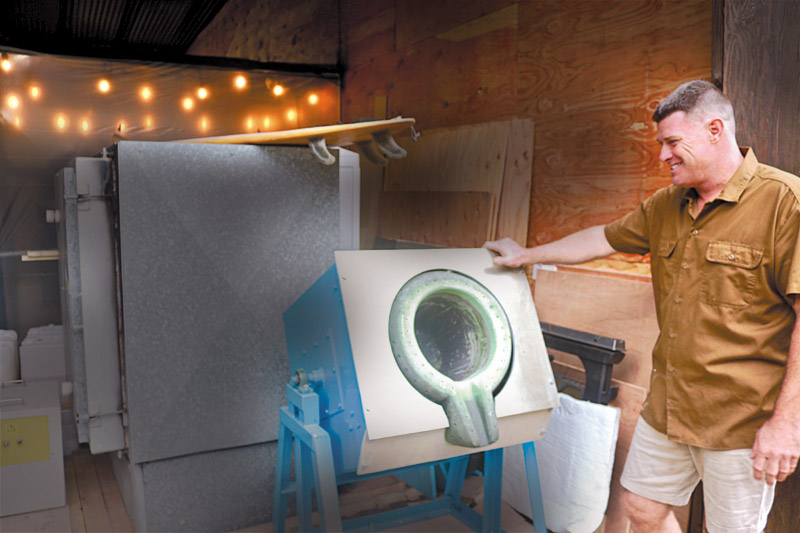The Foundry Father
Artist Chris O’Connor is in the homestretch of finishing to-scale bronze replicas of King Kaumuali‘i and wife Kekaiha‘akÅ«lou, using his newly made shop and induction furnace.
In just five months, sculptor Chris O’Connor will complete work on a life-size bronze sculpture of King Kaumuali‘i and his wife Kekaiha‘akūlou (Deborah Kapule), which will be unveiled on the front lawn of Kaua‘i Museum. The sculpting process will take months to finish, but O’Connor’s journey toward this project began long ago.
For nearly 15 years, he had what he describes as a “yearning to move to Hawai‘i.” Then, in 2016, he made a dramatic change to rebuild his life.
“I had still not visited Kaua‘i and knew nothing of the island aside from its reputation for natural beauty, and its welcoming and loving people,” he says. “However, I was being drawn to Kaua‘i in a spiritual way, and I could almost hear a small voice in the back of my mind telling me that this is where I belonged.”

Chris O’Connor works on the feet of King Kaumuali‘i and Kekaiha‘akÅ«lou. Both sculptures will be on display at Kaua‘i Museum in the coming months.
O’Connor felt he would find his purpose in life on the Garden Isle and made the move more than two years ago with nothing but three suitcases and an open heart.
Soon after arriving on Kaua‘i’s shores, O’Connor visited Kaua‘i Museum. Although the island was new to him, museums have always been a place of familiarity. At the age of 19, O’Connor started work as a taxidermist at the Natural History Museum of Los Angeles County. It was there that his lifelong love of art and sculpture flourished.
He quickly learned to create large fig tree sculptures and dinosaurs, working on mammal reconstructions in the LA museum’s Hall of African Wildlife and dioramas in the North American Hall of Mammals. He then created full-scale dinosaur sculptures at Houston Museum of Natural Science and large-size exhibits at Children’s Museum of Houston.
Thus, when Kaua‘i Museum’s executive director Chucky Boy Chock told O’Connor that a life-size bronze sculpture of King Kaumuali‘i and Kekaiha‘akūlou was in the works, O’Connor felt he had to be the one to create it.
“I knew in my heart my reason for coming to Kaua‘i included creating this statue,” he says. “Creating such an important piece is a career highlight for me. Of all the pieces I’ve created for movies and museums around the world, this sculpture touches me the most.”
The complex process, however, proved even more challenging than O’Connor originally thought.
“Sculptors usually complete a work then send it out to be molded and have the bronze poured,” he explains. “Unfortunately no mold-maker or foundry exists on Kaua‘i.”
Molding a piece and pouring bronze are expensive endeavors — approximately 50-70 percent of a project’s total budget.
In addition to lack of expertise, O’Connor also had to come up with a way to make the process affordable.

A lot of work already has gone into creating the bronze statues of King Kaumuali‘i and wife Kekaiha‘akūlou, and, says sculptor Chris O’Connor, there’s still much more to be done.
“Most any art project comes with some challenge in one form or another, and this piece was no exception,” he adds.
Finally, he concluded that purchasing the equipment and building his own foundry would be the only way forward.
He purchased a large kiln for making the molds and installed an induction furnace capable of melting 220 pounds of bronze.
With that first logistical hurdle complete, O’Connor moved onto the next set of challenges and asked the community for its kōkua.
He ended up finding the perfect location, thanks to Mike Wallace, but it wasn’t able to support the electrical power the induction furnace needed. He had to find an additional space to pour the bronze, and Stan Morinaka and Kaua‘i Veterans Express Co. stepped in to lend aid. In addition, Matson, Honolulu Freight Service and Aloha Isle Moving helped with shipping materials, many of which were donated by Florida’s The Sculpture House.
“Without the community … this artwork would not be possible,” O’Connor adds.
Upon approval of his concept design, O’Connor built a steel frame of Kaumuali‘i and Kekaiha‘akūlou.
“Exactly like a stick figure,” he explains.
He then constructed a foam version around the steel and covered most of the pieces with an oil-based clay to fill out the shapes and add in all the details. (He is currently working on clay molds of the sculpture heads.)
Next, each figure will be separated into segments, so O’Connor can start process of making the wax molds. To do that, he’ll be brushing on a thick liquid rubber that dries to make flexible molds, which will allow him to make a wax copy of each body part. Eventually, each wax copy will be dipped in a liquid ceramic slurry and fine silica sand to create a thick ceramic shell. The wax will melt out as the mold heats to about 1,600 degrees. Meanwhile, O’Connor will heat bronze ingots in his induction furnace to 2,060 degrees, melting it to a liquid that is poured into each mold. Finally, the ceramic shell will be removed and the final bronze parts revealed. O’Connor must then weld each of these bronze pieces together, creating an exact bronze replica of the clay sculpture.
“I’m currently nearing the end of the longest and most tedious part of the process, which is creating the original artwork,” he explains.
He’s created a YouTube channel — complete with with raw footage — that follows the progress of the project. Search “Chris OConnor” on youtube.com. O’Connor has also partnered with Kaua‘i Museum to produce a full-length documentary on the making of the sculpture.
Now, the public has an opportunity to donate to the project and have their names placed on a bronze plaque at the base of the sculpture.
For more information on the project or how to make a donation, visit kauaimuseum.org or call 245-6931.






